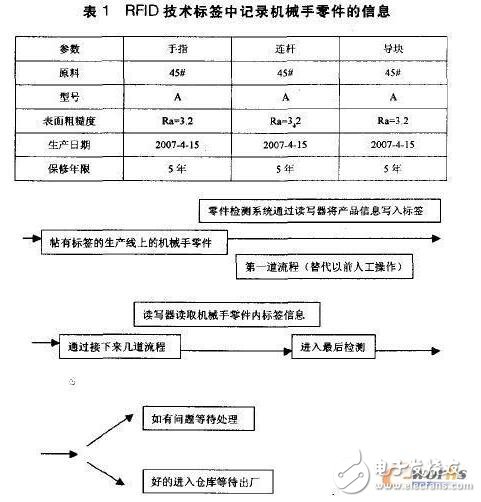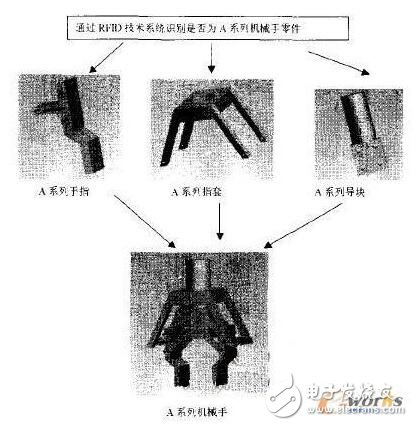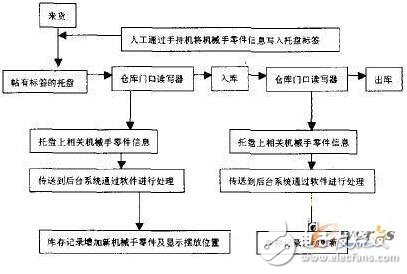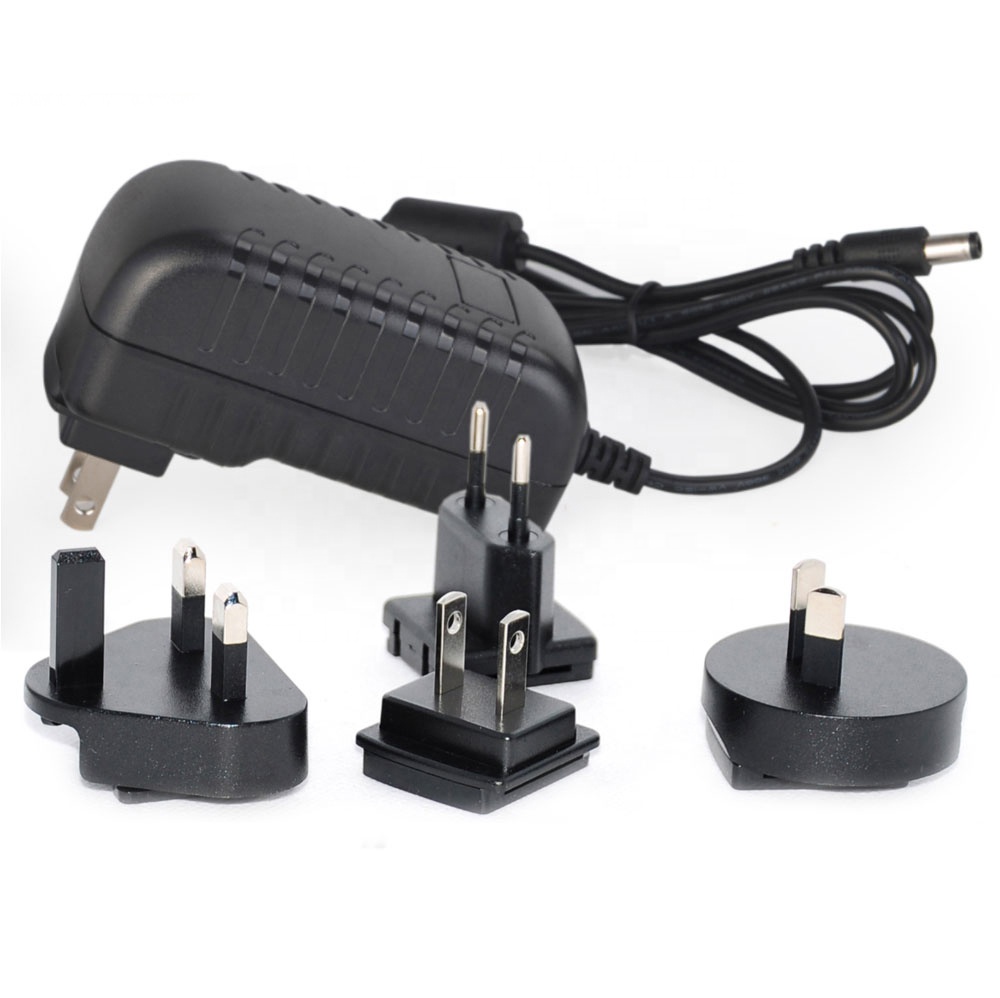With the rapid development of robot applications, there are more and more applications for robots, especially in the case of damage to personnel, so the variety of robot parts has also begun to increase, and the output has also increased. In the face of a variety of robotic parts and a large number, the traditional production management method is to use manual labor management of the robot parts. The key to work efficiency lies in the employees, so the employees are related to the robot parts in the work process. The speed of reading and recognizing the information will have an impact on the accuracy, and the final result will affect the work efficiency and even the ant quality of the robot parts. In the face of the existing management of the robot, we try to use automatic identification technology to improve the management of the robot parts. At present, the existing automatic identification technologies mainly include barcodes, smart cards, magnetic cards and RFID technologies. The use of RFID technology to achieve automatic control and monitoring of products on the production line of robot parts will greatly improve the speed and accuracy of production, improve work efficiency, improve production methods, and save costs. The RFID tag can conveniently and accurately record process information and process operation information on the manipulator parts production line to meet the needs of flexible production. The record of the worker's work number, time, operation and quality inspection results fully realizes the traceability of production, and also avoids mistakes caused by handwriting and visual information in the production environment. Taking Haier Group as an example, in 2003, Haier Group began to track RFID technology. Haier hopes to use RFID technology to automatically recognize the functions of reading, writing, group reading and remote reading, instead of the original close-range artificial barcode reading method. Work efficiency, and in the longer term, capture data through RFID tags in some possible business processes, significantly improving the level of supply chain management. Drawing on Haier's experience, once the chip technology develops to significantly reduce the cost and storage capacity is large enough, the chip label is embedded in the robot parts product - not only the data in the manufacturing process, such as the raw material of the robot parts, the model of the robot, the robot The surface roughness of the part, etc., can also record information about the customer and product warranty. In this way, in the production line of the robot parts, the staff can automatically read the data of Table 1 attached to the label on the robot parts through the system, so that the product information of the robot parts is clear, as shown in Figure 1. Figure 1 Flow chart of RFID technology in the control of robot parts production line Similarly, the assembly line can also be managed using RFID technology. For example, to assemble a set of robots of type A, as shown in Figure 2, by identifying the type information on the RFID tag to determine whether it is the part number to be assembled, and if so, put the next process into the assembly, if not, filter Drop it. Figure 2 Robot assembly flow chart At present, the warehouse management of manipulator parts is mainly realized based on the manual operation of the corresponding specifications and semi-automatic management of the computer. The disadvantage is that a large amount of manpower is required to carry out the work of standardizing the placing of articles, regularly checking the inventory, and registering the inbound/outbound storage. This makes the warehouse management problem of the robot parts very cumbersome and wastes a lot of time. The warehouse management system design of the robot parts based on RFID technology is to realize the automation of the item exit/input control, the storage position and quantity of the items, and the information inquiry process. Managers conduct statistics, inquire and master the flow of materials. Taking the storage management of Shenzhen Baisha Logistics as an example, before and after the end of 2004, the goods entering and leaving the warehouse of Shenzhen Baisha Logistics Base were uniformly placed on the pallet. The entry and exit records were manually recorded by the warehouse administrator and then entered into the computer. The quantity of goods is huge, and the work intensity of warehouse managers is very large. It is inevitable that errors will occur in this, resulting in high management costs and poor management efficiency. The same problem is believed to exist in the robot parts product. For this reason, it is envisaged to propose the following solutions using RFID technology. First, a UHF tag is attached to each tray in and out of the robot parts warehouse, and readers are installed on the door of the warehouse. Each warehouse manager has a handheld device with infrared acquisition. Features. In this way, before each batch of robot parts is put into the warehouse, the warehouse manager uses the handheld to scan the barcode of the robot parts on each tray, record the robot parts, and simultaneously write the label on the tray under the robot parts by RFID, when the tray is When the robot parts enter the warehouse, the reader on the door will directly read the information of the robot parts on the label and store them in the computer. The information management system in the background will automatically generate the records, and accurately record the parts of the robot. In which position of the warehouse, there is no longer a need to ship, and the warehouse management personnel need to look in rows and rows. If someone pushes the pallet out of the warehouse, the back-end system will immediately show that these robot parts have been shipped out and automatically generate a time record. This will not cause the inconvenience of the warehouse management personnel to forget to enter the information into the computer, it is difficult to check the data after the problem occurs, and if the warehouse management personnel themselves will not operate the computer, it will not generate information management. problem. By analogy, if UHF tags are attached to each robot part, each robot part will be displayed on the back-end system immediately, which optimizes the entire management process and reduces the error rate of human factors in the management process. It also saves management labor costs. As shown in the example in Figure 3, the entire manipulator part supply chain management process is simplified and more scientific. The RFID technology solution is to assist in the completion of the robot parts storage management work in such a process. The RFID tag is the carrier of data and information in the storage management of the robot parts. The RFID reader is the data and information collection method in the storage management of the robot parts. It is directly linked to the robot parts storage management system through the software interface, making the object of warehouse management - ----- As long as the robot parts pass through the reader, the details can be displayed in the entire warehouse management information system of the robot parts. In today's logistics integration, many employees can be freed from this simple but cumbersome work. Figure 3 Application flow of RFID technology in robot parts storage management The application of RFID technology in the supply chain management of robot parts is still in its infancy, but the understanding of RFID technology by various enterprises, especially multinational enterprises, has risen to a new stage. Most internationally renowned companies are testing, from procurement, Storage, packaging, loading/unloading, distribution, distribution, and sales to services are all links and processes in the supply chain. They are mutually reinforcing and mutually restrictive. In operation, enterprises must understand and master the business flow, logistics, information flow and capital flow in the whole link in real time and accurately. The flow and change of these four processes make the four processes, as well as each link and process, coordinated. Cooperate with each other to achieve maximum benefits. However, since all links in the moving process of the actual object are in a state of motion and looseness, the information direction often moves and changes in space and time with the actual activity, and the result affects the availability and sharing of information. RFID technology is a new technology that effectively solves the problems of input/output of business operation data, control and tracking of business processes, and reduction of error rate in the supply chain management of robot parts. RFID technology has played a major role in many aspects of the robot parts supply chain. Its main applications are as follows: (1) Robot parts retail RFID technology can improve the inventory management of robot parts retailers, achieve timely replenishment, improve efficiency, reduce errors, while smart tags can monitor the validity of certain time-sensitive robot parts, the seller can also use the RFID system at the payment desk Automated scanning and billing, replacing manual payment methods. (2) Manipulator parts storage link In the robotic parts warehouse, the most widely used RFID technology is in accessing robot parts and inventory counts, which can be used to automate access to robot parts and other operations. Through the management of the entire robot parts warehouse, by combining the receiving plan, picking plan, shipping plan, etc. developed by the robot parts supply chain planning system with RFID technology, various business operations can be effectively performed, such as specifying the robot parts stacking area. , on the shelf to take up the manipulator parts. This enhances the accuracy and speed of the job, improves service quality, reduces costs, saves labor and inventory space, and reduces misplacement, misdelivery, theft, damage, inventory, and shipping errors in the entire robot parts logistics. Loss caused by etc. Another advantage of RFID technology is the reduction in manpower in the inventory of robot parts. The use of RFID technology to automate the registration of robot parts, without the need for manual inspection or scanning barcodes, is faster and more accurate. (3) Manipulator parts transportation In the management of robot parts transportation, the robot parts and vehicles transported in the path are controlled by attaching RFID tags to them, such as attaching labels to containers and equipment. RFID receiving and forwarding devices are usually installed at some checkpoints on the transportation line (such as on the doorpost, next to the pier, etc.), as well as at key locations such as warehouses, stations, terminals, and airports. After receiving the RFID tag information, the receiving device uploads to the communication satellite along with the location of the receiving place, and then transmits it to the transportation dispatching center to be sent to the database by the satellite. (4) Manipulator parts distribution / distribution In the robot parts distribution, the use of RFID technology can greatly speed up the distribution of robot parts and improve the efficiency and accuracy of the picking and distribution process, and can reduce labor and reduce distribution costs. All robot parts that arrive at the central distribution center are tagged with RFID tags. When entering the central distribution center, the trays read the contents of the tags on all the containers on the pallet through a door reader. The system checks these shipment records to detect possible errors and then updates the RFID tags to the location and status of the latest robot parts. This ensures accurate robot part inventory control and even knows exactly how many robot parts containers are currently in transit, the origin and destination of the transfer, and the expected arrival time. This paper proposes a set of general analysis frameworks from general characteristics to generative summary analysis to problem-solving strategies, enabling RFID technology to contribute better to robotic drawings, parts production management, warehouse management, and supply chain management. .
5V Switching Wall Charger Power Adapter for Home Electronics
5v wall charger,5v 2a wall charger,5v 3a wall charger,5v power charger,switching 5v charger,5v 1a Wall Wart Transformer Charger,5v 2a Wall Wart Transformer Charger,5v 3a Wall Wart Transformer Charger,5V 2A/2000mah AC Power Adapter Adaptor Wall Charge Shenzhen Waweis Technology Co., Ltd. , https://www.waweispowerasdapter.com



Micro USB:
Original back-and-white display Kindle 1st Gen, Kindle Fire Kindle HD Fire HD 6 8 10 HDX 7 8.9 9.7, Samsung Galaxy S7/Edge, S6/Edge, S5, S4, S3, S2, Si9003, S5820, N7100, Note3, Note4
5.5mm x 2.1mm:
For Bluetooth speakers/ Electronic Toys/ Mini Fan/ Portable Air Conditioner/ LED Pixel Light/ Monitor/ Camera/ Webcam Router/ Cable Modem/ USB-HUB/ photo player/ SCM development/ access control attendance ect.
4.0mm x 1.7mm:
For mp3 mp4 speaker CCTV camera power supply connection/ digital picture frame/ shower Christmas lights/ Sabrent USB HUB/ digital recorder ect.
3.5mm x 1.35mm:
* For Facial Cleansing Brush: Foreo Luna 3/ Luna 3 Plus/ Luna/ Luna2/ Luna Mini/ Luna Mini 2/ Luna Go/ Luna Luxe, ISSA Series E-Toothbrush ISSA / ISSA Hybrid / ISSA mini / ISSA Mikro / ISSA play, ESPADA Acne Treatment Device, IRIS Eye Massager
* For Fairywill Sonic Electric Toothbrush FWP11 FW507 FWD1 FWD3 FWD8 FW917 FW2001 FWE11 FWE11 FW917 FWT9 ect.
* For LELO Ida, Lyla, Lyla 2, Oden, Oden 2, Ora, Ora 2, Tara, Alia, Isla, Soraya, Inez, Yva, Mia, Mia 2, Nea, Nea 2, Lily, Lily 2, Liv, Liv 2, Gigi, Gigi 2.
* For LELO Mona, Mona 2, Mona Wave, Ina, Ina 2, Ina Wave, Siri, Siri 2, Iris, Elise, Elise 2, Billy, Tor, Tor 2, Bo, Hugo, Bruno, Hula Beads, Loki, Loki Wave.